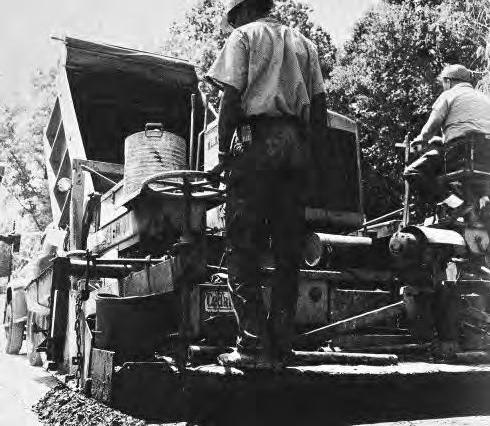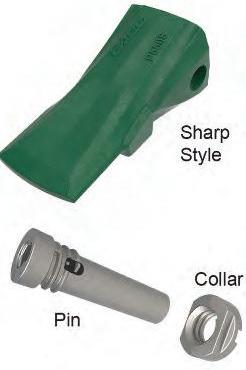
11 minute read
Attachments Section
BLYTHE from page 1
Today, Blythe Construction is a full-service construction company capable of handling projects of virtually unlimited size and scope. It annually produces some $400 million in revenue, evenly split between heavy highway construction and asphalt paving. While it hasn’t a single mule in its stable of equipment, more than 400 state-of-the-art machines are cranked up each week to work job sites across North Carolina.
What’s more, Blythe also is involved in projects in South Carolina and, as part of Eurovia USA, the full length of the East Coast and in Texas. It is working on 25-30 construction projects at any given time, most of them in North Carolina, with fully 65 percent of the company’s annual revenue generated in the Charlotte metro area.
While the scale of Blythe Construction operations since 1921 has grown exponentially, the expansion doesn’t seem to have unmoored the company from its core principles. Blythe’s senior vice president of construction, Brian Webb, said he believes the company operates with the same business ethos as in the beginning.
“Blythe long has been recognized as a leader in state highway work in North Carolina, as a company that delivers projects on time,” he said. “We still do that today. Over the years, we have managed to retain the respect of stakeholders as a dependable partner.”
Webb, who has been at Blythe for 23 years, was asked if one project or another stands out in memory for the size of the contract or the difficulty in completing it. He said none does.
“Each project reflects the character of the work that we do. Whether it is a $500,000 parking lot for CVS Pharmacy or a multi-lane highway project, it is a proud moment for us when we finish it. No matter the size of a project, we work to complete it on time, within budget, and safely.” **
In the decades following its founding, Blythe Brothers grew its highway construction and paving business. World War II impacted its business model, with the company contracting to build part of the brand new U.S. Marine Corps training base in Jacksonville, N.C., called Camp Lejeune. Other tangents included establishment in the following decade of asphalt paving subsidiaries in Puerto Rico and the Virgin Islands, enterprises that eventually folded.
In the mid-1980s, Blythe Brothers entered a period of ownership changes. First, the company was renamed Blythe Construction when it was acquired by Alfred McAlpine, a British construction group. That association lasted for more than a decade. In 1998, Blythe Construction was sold and became part of Hubbard Construction, a heavy general contractor that still works the length and breadth of Florida. Two years later, Hubbard Group, including Blythe, was acquired by Eurovia, which is a division of VINCI Construction, headquartered in France.
So, today, Blythe Construction is a subsidiary of a transportation construction and commercial development organization that operates in 16 countries. Multi-level corporate structure notwithstanding, Blythe and the other Eurovia subsidiaries operate quite autonomously, while at the same time having the resources of Eurovia to draw upon.

Asphalt plant located in Kings Mountain, one of 12 plants owned and operated by Blythe in the Carolinas. After shutting down last fall for winter maintenance, the facility was upgraded and enhanced with the addition of three 30,000-gallon liquid asphalt silos, a new Astec control tower, and a fresh coat of paint. As of April, the plant is up and running at a max capacity of 400 tons per hour.

see BLYTHE page 40

Pages 31-37SECTIONAttachments

For more information about these attachments and more, visit our Attachments Section on our Web site at www.constructionequipmentguide.com

Is Your Quick Coupler Compliant?
For construction contractors, equipment dealers and manufacturers, safety should be the number one responsibility. Protecting employees and customers is not negotiable and must be the number one priority in the decision-making process.
Every day, across the world, buckets fall from machines causing serious injury and even fatalities. As reported by OSHA, this is frequently caused by buckets disengaging unintentionally from excavator quick couplers. Geith believes it’s everyone’s responsibility in this industry to prevent these accidents from happening.
From its experiences it has found that there are three main reasons why buckets accidently fall from excavators when using a non-compliant ISO 13031 quick coupler: 1. Misconnection
If using a quick coupler without a front lock and misconnection occurs (the operator doesn’t attach the bucket correctly) the bucket may fall from the quick coupler when operations begin. 2. Cylinder failure/Loss of hydraulic pressure
If using a quick coupler that relies on hydraulic pressure to engage the attachment and the quick coupler loses hydraulic pressure through a leak or cylinder failure, the engagement system can gradually open causing the bucket to fall unexpectedly during operations. 3. Accidentally opening a Quick Coupler in an unsafe position
Using a quick coupler with a control system that allows a quick coupler to be opened in any position or orientation can result in unintentionally releasing a bucket in a dangerous position, causing a bucket to fall.
ISO 13031 Earth-Moving
Machinery – Quick Couplers – Safety
The development of quick coupler related safety standards such as ISO 13031 Earth-Moving Machinery – Quick Couplers – Safety, has been a game changer across the global construction sector.
It was developed in cooperation between global health and safety organizations, machinery and quick coupler manufacturers with the goal to eliminate growing safety concerns following several fatal accidents where excavator buckets became detached from some quick couplers during operation.
The standard outlines minimum operation and safety requirements that quick couplers must meet in order to be compliant.
By using a ISO13031 safe compliant quick coupler this helps prevent buckets accidently falling from excavators in these three scenarios mentioned above. How? 1. Misconnection
By using a quick coupler with a front lock, if misconnection occurs the bucket is secured by the front lock preventing it from falling. 2. Cylinder failure/Loss of hydraulic pressure
By using a quick coupler that has added additional locks to the engaging process this keeps the bucket in a default locked position even with the loss of hydraulic pressure or cylinder failure via internal safety springs. 3. Accidentally opening a Quick Coupler in an unsafe position
By using a quick coupler with a curl to release control system (a two-step operation control system). This only allows the attachment to be released in a safe position after getting a signal from the hydraulics. This prevents a Quick Coupler being opened in an unsafe position and prevents a falling bucket.
All quick couplers are not equal. Regardless of the quick coupler you use, ask yourself this question: Is your quick coupler safe and compliant?

The development of quick coupler related safety standards such as ISO 13031 Earth-Moving Machinery – Quick Couplers – Safety, has been a game changer across the global construction sector. The MaxDRP Plus J-Series replacement teeth are currently available in abrasion, chisel and sharp profiles in 450 through 800 sizes. R-Series replacement teeth are offered in popular abrasion and penetration profiles in R450 through R550 sizes.


ESCO Offers MaxDRP Replacement Teeth
ESCO recently increased the offering of the MaxDRP replacement teeth with the MaxDRP Plus System for J-Series teeth and R-Series rippers.
Caterpillar assemblies are easily converted to MaxDRP Plus replacement teeth with no modification to the existing nose, according to ESCO.
ESCO’s MaxDRP teeth have enhanced profiles over conventional J-Series and R-Series teeth that provide greater strength, improved production and longer wear life.
Designed for safety and ease-of-use, the MaxDRP Plus system utilizes a unique pin and collar locking system. The hammerless system does not require any special tools which increases site safety and allows faster tooth replacement.
In addition, ESCO superior point alloy has an average hardness of 525 Brinell without sacrificing impact toughness. The closest competitor is in the 470 Brinell hardness range, according to ESCO.
The result: ESCO alloys and refined profiles deliver up to 25 percent longer wear life - significantly reducing maintenance costs and unplanned downtime.
The MaxDRP Plus J-Series replacement teeth are currently available in abrasion, chisel and sharp profiles in 450 through 800 sizes. RSeries replacement teeth are offered in popular abrasion and penetration profiles in R450 through R550 sizes.
For more information, visit www.esco.weir.





JOBS from page 1
construction, engineering and accounting by the year 2030. Doug Holtz-Eakin, former Congressional Budget Office director, speaking with Fox Business said more than 880,000 middle-class jobs could materialize if the bill passes a Sept. 27 vote.
Michael Pugliese, economist of Wells Fargo Securities, told the Associated Press the infrastructure deal would likely have a modest impact on job creation and unemployment. He believes it could help the U.S. jobless rate fall below 4 percent by 2023.
Though Peter Williams, an economist of the investment firm Evercore ISI, said the infrastructure package probably won’t start to boost economic growth until 2023, in 2025 and 2026 the extra package would add a healthy one percentage point to the economy’s growth rate. According to AP News, Williams estimated infrastructure programs will create up to approximately 775,000 jobs.
Badly Needed Boost
Mark Zandi, chief economist of Moody’s Analytics, pegged it at 650,000 new jobs, some of which would be in manufacturing. He said pay could average about $70,000 a year.
“Just take a look at a construction site,” Zandi said in an interview with marketplace.org. “Those are the kinds of things — manufactured things — that will be needed for these projects. Of course, it takes all kinds of people to produce those types of manufactured goods.”
One of the undeniable elephants in the room is the continued demand for skilled construction workers. It’s been the bane of the construction industry’s existence for years now. The money and opportunities in the infrastructure plan are encouraging, but bringing it all to fruition may be impossible without workers, let alone well trained and qualified workers.
Harry Holzer said the bill’s broad range of new construction activity will require a range of skilled construction and manufacturing workers. Holzer is LaFarge Professor of Public Policy at Georgetown University and a nonresident senior fellow in Economic Studies at Brookings
He noted that while President Joe Biden proposed $100 billion in new training over eight years, “the summaries of the bipartisan infrastructure bill released to date are mostly silent on the need to train more workers for the jobs it will create.”
Speaking with The Hill, he said any major new funding for workforce training would have to be allocated through the upcoming reconciliation bill.
Holzer wants to see “substantial” new job training funds added to the bipartisan bill. Senators who have pushed for workforce training in the past should work again to make funding for workforce training a top priority in the reconciliation bill, he said.
“With the apparent creation of hundreds of thousands of new and well-paying jobs in the United States, and with millions of workers already needing such training, our legislators need to make workforce training the top priority that it deserves to be.”
Democrats will push for money to train U.S. workers for infrastructure jobs, Henrietta Treyz with investment firm Veda Partners told marketplace.org. She thinks it’ll be hard for members of Congress to vote against the Infrastructure Investment and Jobs Act.
“You have to focus on things that can get substantial bipartisan support, and infrastructure and job creation is like vanilla ice cream — everybody loves it,” Treyz said.

The massive bipartisan infrastructure bill is forecast to create nearly a million jobs in construction, engineering and accounting by year 2030. Current skilled labor shortages will challenge jobs creation.
New funding for workforce training is needed, say economists. And senators who have pushed for workforce training in the past should again make it a top priority in the infrastructure reconciliation bill. Practicing Self-Care
The AGC, which tracks workforce numbers, doesn’t love the shortages the construction industry has seen over the years. Earlier this month, the association announced shortages had reached pre-pandemic levels despite the coronavirus and supply-chain disruptions.
“Market conditions are nowhere near as robust as they were prior to the onset of the pandemic,” said Ken Simonson, the association’s chief economist. “At the same time, the pandemic and political responses to it are limiting the size of the workforce, leading to labor shortages that are as severe as they were in 2019 when demand for construction was more robust.”
Stephen Sandherr, association CEO, said the federal government currently spends only one dollar on career training for every six it puts into college prep.
“Boosting federal investments in career and technical education will help attract and prepare more people into high-paying careers in construction,” said Sandherr.




